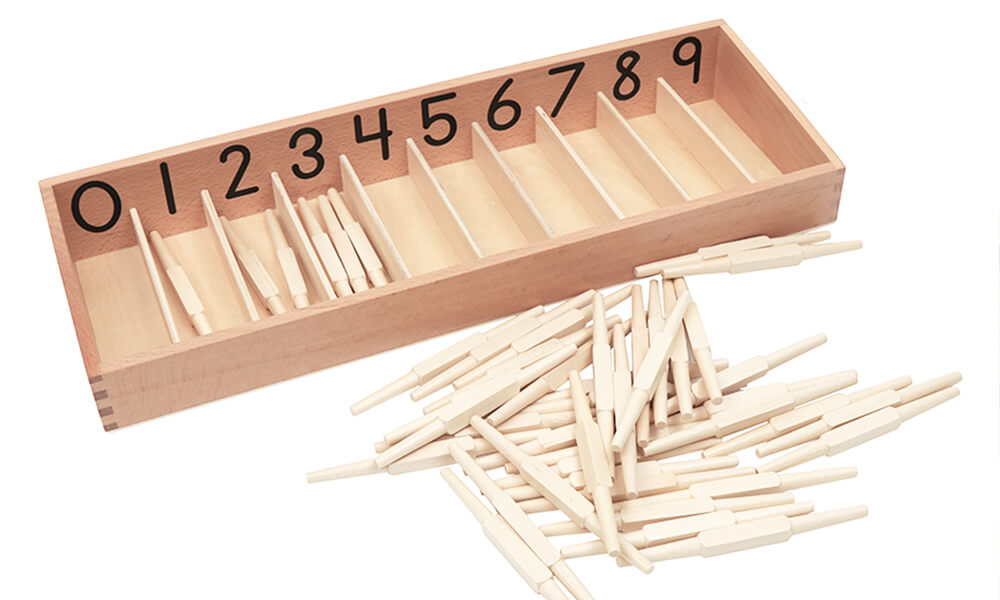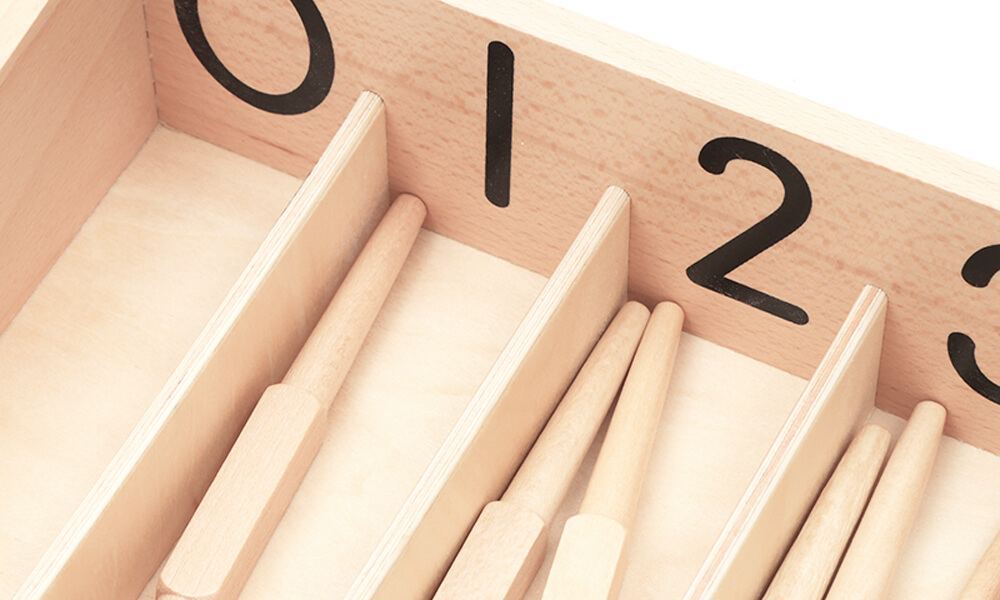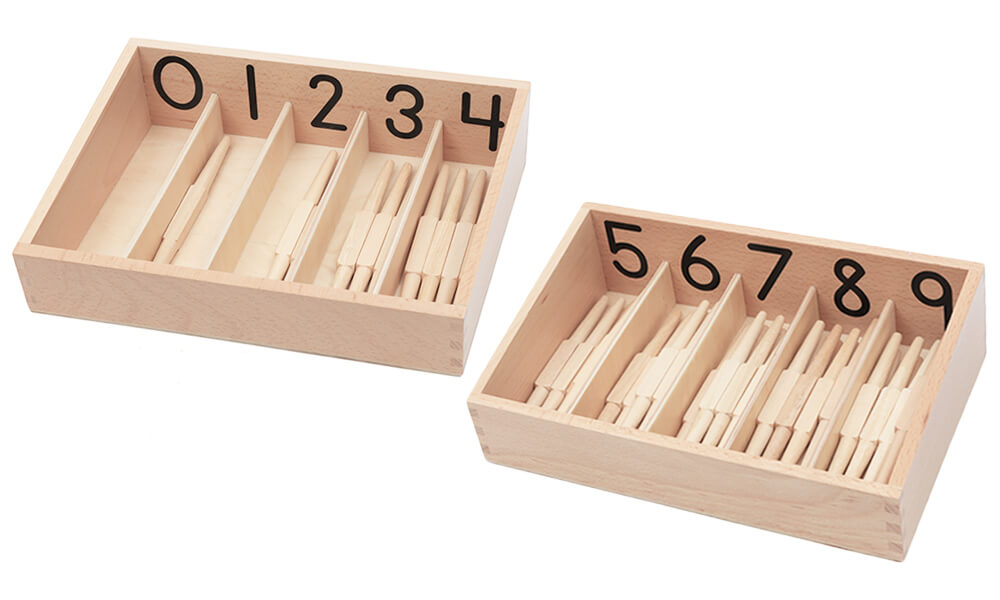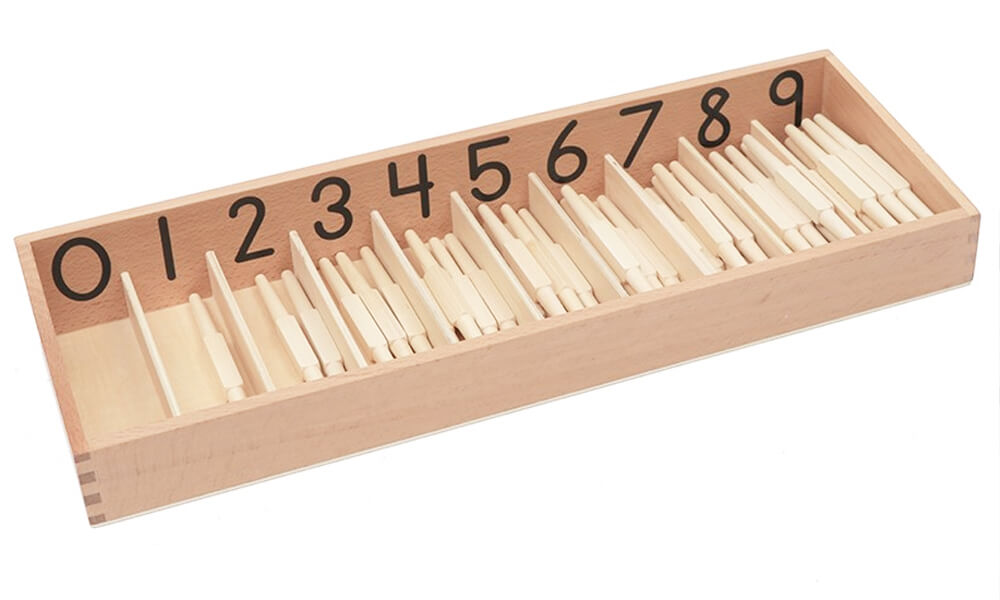Spindle boxes are a classic Montessori tool used to help children learn basic spatial perception and hand-eye coordination. It is an effective tool that can be used to help children develop the skills they need to succeed in life. In this guide, we will take a look at what the Montessori Spindle Box is, its benefits, and how you can make use of it in your child’s education.
What is Montessori Spindle Box?
The spindle box is a Montessori educational material used to teach children basic math concepts such as counting, number recognition, place value, addition, subtraction, and more. It consists of a tray with labeled compartments, and a set of wooden spindles that can be placed in the compartments to practice counting and grouping quantities.
The exercises with Montessori spindle box can be done with ribbons to bind the counted spindles into a bundle before placing them in the compartments. The child is shown how to use the shorter ribbons for smaller bundles and then progress to longer ribbons for larger bundles. This helps to reinforce the concept that counted quantities represent a set.
Montessori Spindle Box Purpose
The Montessori spindle box is used to demonstrate that numbers can represent a group of distinct objects, rather than just the amount of one property. It also provides an understanding of the concept of ‘zero’ and the realization that the symbols “0” to “9” are sufficient for arithmetic.
The spindle box is used to present the numerals from 0 to 9 in order, associate the corresponding quantities with each numeral, and introduce the concept of zero. It allows children to see the sequence of numbers on the box and handle the quantities in a hands-on way. This material is different from the number rods and tactile numerals, where the sequence of numbers is indicated by the segmented rods and the numerals are separate.
Montessori Spindle Box Presentation
The Montessori spindle box contains 45 spindles, which corresponds to the total of the numbers 1 to 9. This allows children to complete the exercise with the exact number of spindles required. If an error is made, the child will quickly realize that there are either too many or too few spindles in the final compartment. This allows them to independently correct their work and improve their problem-solving skills.
Spindle boxes consists of a tray with two sections, each with partitions labeled with the numbers 0 to 4 for one and 5 to 9 for the other. A box containing 45 wooden spindles and 8 ribbons of different lengths, ranging from 5 inches to 12 inches, complete the material.
- To use this material, the child must first lay out a floor mat. Then show them how to place the two sections of the tray next to each other to create a single tray with ten adjacent partitions. The wooden spindles and ribbons should be kept in their own separate box.
- Ask the child to read the numbers on the partitions. If the child is unsure of any of the numbers, provide the Number Tablets and guide the child to match the number on the partition with the corresponding numeral on the tablet.
- When using the spindle box, point to the partition labeled “1” and say “one”. Take one spindle from the box, count “one” as you place it on the mat, and then place it in the partition labeled “1”.
- Point to the partition labeled “2” and say “two”. Take two spindles out of the box, count them one by one as you place them on the mat, saying “one, two” and then place the two spindles in the partition labeled “2”.
- Continue the process of pointing to the partitions, saying the corresponding number and removing the corresponding number of spindles from the box and placing them on the corresponding partition, until all 45 spindles have been divided among the partitions.
- Then, point to the partition labeled “0” and say “zero” and demonstrate that there are no spindles in that partition.
- Once all the spindles have been divided among the partitions, return them all back to their box and invite the child to have a turn doing the exercise.
Montessori Spindle Box Benefits
The Montessori Spindle Box is a mathematical material that helps children understand the concepts of quantity, numeration, and the base 10 number system.
Some benefits of using the Montessori Spindle Box include:
- Developing the child’s visual and tactile perception of numbers and quantities.
- Helping the child to understand the concept of zero and its place in the number system.
- Encouraging the child to develop independence and self-correction skills as they can identify and correct their own mistakes.
- Providing a concrete and hands-on experience with numbers and quantities, which can help the child to understand abstract mathematical concepts.
- Introducing the child to the base 10 number system, which is the foundation for more advanced mathematical concepts.
Overall, the Montessori Spindle Box is a valuable tool for introducing children to the world of mathematics and helping them to develop strong mathematical foundations.
Montessori Spindle Box Lessons & Exercises
The Montessori Spindle Box is a valuable tool for teaching children about counting, quantity comparison, and number recognition. The child sorts and counts the spindles, placing them in labeled compartments, following a demonstration. An additional exercise involves using ribbons to bind the counted spindles into bundles before placing them in the designated compartments. This reinforces the concept that counted quantities represent a set.
The child can make observations about each bundle and notice weight and space differences. The Spindle Box can also be used to teach basic addition and subtraction, place value, and the concept of zero. Exercises can be made fun by using the ribbons to compare the spindles with their length. The child can work independently and correct their mistakes on their own.
- The child counts and sorts the spindles into the labeled compartments, following the demonstration.
- Similar to exercise number 1, the child uses ribbons to bind the counted spindles into a bundle before placing them into their designated compartment. The child is shown how to use the shorter ribbons for smaller bundles and then progress to longer ribbons for larger bundles.
Reinforcing the concept that counted quantities represent a set is crucial in the Montessori Spindle Box exercise. Once the activity is finished and all quantities are grouped, the child can make observations about each bundle. They may notice the weight difference between a bundle of seven and a bundle of three or comment on the amount of space the different quantities take up in their hands.
The following are some more lessons and exercises that can be done with the Montessori spindle box:
- Number Recognition: The child can match the numerals on the partitions to the corresponding quantity of spindles in the box.
- Counting: The child can count the spindles and place them in the correct partitions, starting from the “0” partition.
- Quantity Comparison: The child can compare the quantities of spindles in different partitions and understand the concept of more and less.
- Addition and Subtraction: The child can use the spindles to practice basic addition and subtraction.
- Place Value: The child can understand the concept of place value by placing the spindles in the correct partitions, i.e. ones, tens and hundreds
- Zero: The child will understand the concept of zero and its importance in the number system.
- Exercises: The child can have fun counting the spindles, and placing them in the correct partitions, can also use the ribbons to compare the spindles with the length of the ribbon
- Independent work: The child can work independently with the Spindle Box and correct their mistakes by themselves.
How To Make Your Own Spindle Box?
To make your own Montessori spindle box, use new, unsharpened pencils as “spindles” and divide two shallow cardboard boxes (wide enough to hold a pencil) into five partitions each. Write the numbers “0”, “1”, “2”, “3” and “4” on one box and the numbers “5”, “6”, “7”, “8” and “9” on the other box in the same style of writing as the number tablet. Store the forty-five pencils in their own separate box.






I really love this spindle box presentation its really very help for me to teach a child & even the child is also like to do this activities